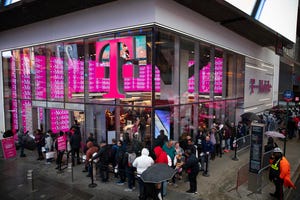100G Watch: 40G Strikes Back
Data centers would love 100 Gbit/s if it didn't cost so darned much

The news around 100-Gbit/s developments has understandably slowed in the wake of OFC/NFOEC, but a few new developments have passed our way lately.
First, the anti-100-Gbit/s news: Force10 Networks Inc. is coming out saying that 40 Gbit/s will be more useful to enterprises than 100 Gbit/s.
"Our plan is to push the concept of, and to support a pull of, 40-Gbit/s Ethernet being a better option than 100-Gbit/s Ethernet for data centers," says Kevin Wade, Force10 senior director of marketing. (See Force10 Pushes 40G.)
The reason is simply the cost -- "over $30,000 for just the optical module alone," Wade says. "That's not for a port, just a module."
Were it not for the cost, plenty of data centers would be grabbing for 100-Gbit/s Ethernet, Wade says. Their bandwidth needs are more pressing" than the carriers', he says. "They were the earliest adopters of 10-Gbit/s Ethernet, sooner than it was being adopted by core routers."
But 40-Gbit/s optics have had longer to come down in price, in the form of OC768 Sonet or 40-Gbit/s Infiniband.
How about some products to back up this 40-Gbit/s push? Force10 has been describing its products as being ready for 40- or 100-Gbit/s Ethernet, and a new line cards will accompany the 40-Gbit/s preaching. They won't arrive until after mid-year though, and Force10 isn't giving up any details.Altera Corp. (Nasdaq: ALTR) is saying its Stratix V FPGAs will be the vehicle for its 28-Gbit/s transceiver ("transceiver" meaning an on-chip transmitter and receiver, not an optical part). It looks like the first 28-Gbit/s transceiver to hit the common market in any form.
That's an important step for 100-Gbit/s transport, because a 100-Gbit/s stream with Forward Error Correction (FEC) could be split among four of those transceivers, as opposed to using 10 transceivers that run at 12.5 Gbit/s.
The 28-Gbit/s serializer/deserializer will run at 200 mW, which Altera says is pretty spiffy. "It's not uncommon to see a 3-Gbit/s channel consume 150 mW," says Luanne Schirrmeister, senior director of component product marketing.
What makes the 28-Gbit/s transceiver tick is, coincidentally, a 28nm manufacturing process. Altera announced in January that the chip would be going to 28nm and made good on that with Monday's announcement. (See Altera Unveils 28nm Stratex V.)For short-haul 100-Gbit/s transmission -- distances of 40 kilometers or less -- Nokia Networks says it's completed tests showing the use of one optical transceiver rather than four.
The result, announced last week, was the culmination of a European Union-funded project called Hecto, short for "high-speed electro-optical components for integrated transmitter and receiver in optical communications." (We'll stick with "Hecto.") The project started in November 2006.
NSN collaborated with research institutes and optical components vendors on Hecto. Pieces developed included a driver amplifier and multiplexer on the transmitter side, and for the receiver, a demultiplexer, integrated clock-and-data recovery, and a monolithically integrated photodetector and amplifier.
Elsewhere in 100-Gbit/s-related news:Ethernet Europe: AboveNet Eyes 100G First
Arista Grows Up, Pumps Iron
Corning Creates 100G Patch Cord
100G Startup Bags $7.2M
— Craig Matsumoto, West Coast Editor, Light Reading
About the Author(s)
You May Also Like











